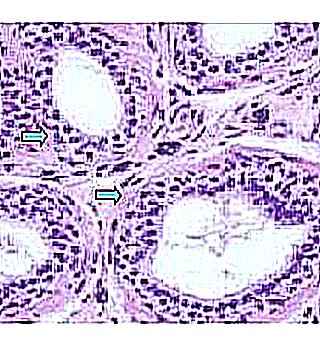Home >
Erectile Dysfunction >
Overgrowth of fibrous connective tissue in the prostate
Overgrowth of fibrous connective tissue in the prostate

Periurethral fibrosis of the prostate is a somatic disease that morphologically manifests itself as a pathological proliferation of connective tissue instead of glandular structures. Fibrous changes eventually lead to dysfunction of the prostate and a disease with impaired male reproductive function.
About how this disease manifests itself and what it is, most urological specialists tried to study it, and that is why this pathological process is today considered to be the final stage in the progression of prostatitis with a chronic course.
Etiological factors in the development of the disease
As a rule, prostate fibrosis develops against the background of prolonged progression of infectious processes in the prostate gland and organs of the urinary system, which lead to intensive destruction of physiologically organized and functioning organs.
This pathological process also involves the mechanisms of proliferation of cells containing fibrin filaments in their structural composition, this also leads to chronic inflammatory processes.
The predisposing factors preceding this pathology are the following diseases:
- Bacterial and non-bacterial inflammatory change in the tissues of the prostate, which proceeds in a chronic manner.
- Blockage or damage to the endothelium of arterial vessels by atherosclerotic plaques.
- Complete abstinence from sexual intercourse for a long time.
- Frequent sexual intercourse with suspicious sexual partners, and infection with sexually transmitted infections.
- Allergic reactions of local or anaphylactic type.
- Presence of autoimmune or rheumatic pathologies of the connective tissue.
- A sharp change in the secretion and circulation of hormonal substances in the body.
Despite all the listed etiological factors, the main reason for the development of prostate fibrosis is prostatitis in a chronic course.
How is this disease symptomatic?
If the patient has developed paraurethral sclerosis of the glandular tissue of the prostate with fibrous degeneration, the main symptoms of the disease should be highlighted:
In addition, a patient diagnosed with prostate fibrosis may present such complaints as:
If, with a lesion of the prostate, treatment was not carried out in a timely manner, acute renal failure develops against the background of delayed outflow of urine.
Diagnostic activities
To make a final diagnosis, patients need to undergo all the necessary diagnostic procedures, which include:
- General laboratory tests of peripheral blood and urine.
- Magnetic resonance imaging.
- Ultrasound examination of organs located in the pelvic region and in the retroperitoneal space.
- If necessary, diagnostic laparoscopic surgery is performed.
Only a qualified urologist can choose the tactics of conducting diagnostics and making a final diagnosis.
Carrying out treatment activities
In this disease, conservative methods including drug therapy are considered ineffective, since irreversible structural changes have occurred in the prostate tissue, which are corrected only with surgery.
Medication drugs are prescribed only for the purpose of symptomatic treatment, these include:
- non-steroidal anti-inflammatory drugs;
- antibacterial agents;
- vitamins;
- drugs affecting blood clotting;
- anti-cholesterol therapy.
Trans rectal massage of prostate tissue is considered ineffective because the organ is structurally altered and has pronounced functional disorders.
It is strictly forbidden to engage in self-treatment of the disease, as this can lead not only to a negative effect, but also to the development of specific complications:
The main type of treatment for this disease is planned surgery, which has several types:
- Removal of the part of the organ that underwent sclerotic fibrotic changes.
- Complete removal of the pathologically altered organ.
- Total organ resection within healthy tissue structures.
Sclerotic changes in the prostate gland are dangerous for men and can precede cancer, which is why every man should start taking medical measures in a timely manner.



























